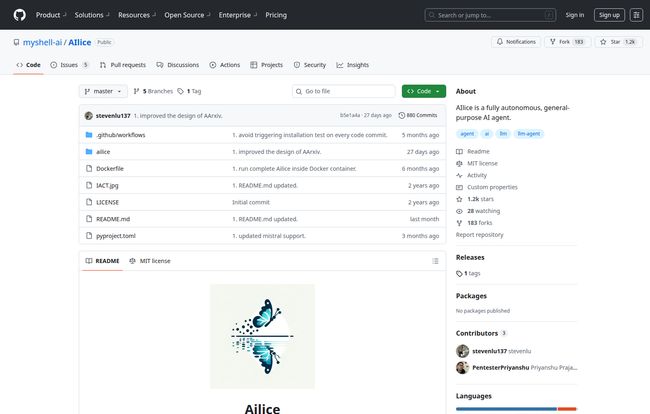Ever since Tony Stark fired up JARVIS in the first Iron Man, I think a part of every tech nerd has dreamed of having their own AI assistant. Not just a smart speaker that can tell you the weather, but a real, thinking partner that can manage tasks, write code, and do deep research. We've seen a lot of contenders pop up, especially in the last year or two. Some are slick, polished commercial products behind a hefty paywall. Others are… well, let’s just say they are more experimental. And then, there's AIlice.
I stumbled upon AIlice on GitHub recently, and I have to admit, my curiosity was piqued. The description calls it a "lightweight AI Agent" that aims to be a JARVIS-like assistant by using a Large Language Model (LLM) as its brain. It's an open-source project, which always gets extra points in my book. But does it live up to the hype? Let's get into it.
So, What Exactly is AIlice?
Think of it this way: AIlice attempts to build a "text computer." Instead of a silicon CPU, it uses an LLM as its core processor. You give it a task in plain English, and it uses the LLM's reasoning ability to figure out the steps, call on different tools (like a web browser or a code interpreter), and get the job done. It’s designed to be a generalist, capable of handling everything from complex research to system administration.
Now, one important thing to clear up right away. AIlice is an open-source project hosted on GitHub. That means the software itself is free. You might see pricing pages on GitHub, but that's for their hosting services (like private repositories and team features), not for the AIlice code. It’s a community-driven effort, which is both its biggest strength and, as we'll see, a source of some of its quirks.

Visit AIlice
The Core Features That Caught My Eye
Flicking through the documentation, a few things really stood out to me as more than just buzzwords. These are the capabilities that make AIlice more than just another weekend project.
Unbelievable Versatility: From Research to System Admin
The range of tasks AIlice claims to handle is pretty wild. It’s not just a one-trick pony. We're talking about the ability to conduct in-depth research on a specific topic, read through academic papers to give you a summary, and even automate programming tasks. I can imagine telling it, "Research the latest algorithm changes for Google Discover and write a Python script to analyze the traffic patterns on my blog for the last three months." That’s the dream, right?
The Power of Choice: Open-Source and Commercial LLMs
This, for me, is the real game-changer. The AI space is currently having a massive debate: do you stick with private, powerful, and expensive commercial models like OpenAI's GPT-4, or do you embrace the privacy, control, and no-cost-per-token world of open-source models like Llama or Mistral? With AIlice, you don't have to choose. It’s built to work with both. You can run a small, local model on your own machine for privacy-sensitive tasks, or you can hook it up to a commercial API for when you need maximum brainpower. That flexibility is fantastic.
Built to Grow: Extensibility and Self-Construction
Here’s where it gets really geeky and cool. AIlice is designed to be extensible. It has this capacity to self-construct and dynamically load new modules to interact with its environment. In simpler terms, if it needs a new tool to complete a task, it can theoretically build it itself. It's like your assistant not only knowing how to use a screwdriver but being able to forge a new, custom one when the situation calls for it. This opens up a ton of possibilities for customization by the community.
My Honest Take: The Good, The Bad, and The Geeky
Okay, let's talk turkey. I installed it and played around with it for a bit. It’s one thing to read a feature list, its another to see it in action.
The good stuff? It's genuinely lightweight. I was expecting a clunky, resource-hungry beast, but the installation was pretty straightforward for anyone comfortable with a command line. The architecture behind it, what the creators call an "Interactive Agents Calling Tree," is also really smart. My take on it is that it acts like a project manager for AI agents. It can delegate a main task into smaller sub-tasks, and if one of the sub-agents fails or gets stuck, the system doesn't just crash. It's fault-tolerant, able to backtrack and try a different approach. That’s a big improvement over some of the earlier, more brittle agent frameworks.
But, and this is a big but, you need to go in with the right expectations. This is not a polished, consumer-ready product. It's a tool for developers, researchers, and hobbyists. It’s still under heavy development, so you might run into bugs or compatibility issues. For instance, you have to manually configure the virtual environments for it to execute code, which can be a bit of a faff. And the biggest issue I noticed is the lack of a simple runtime control. If you give it a poorly defined task, it can get stuck in a loop, burning through API credits or CPU cycles. You have to be ready to step in and manually stop it. It’s a powerful tool, but it doesn't have all the safety rails yet.
Who is AIlice Actually For?
So, should you drop everything and install AIlice? It depends on who you are. If you're a business owner looking for a simple, plug-and-play AI that your whole team can use tomorrow, this probably isn’t it. Not yet, anyway.
But if you are a developer, an AI enthusiast, a researcher, or just a curious tinkerer who loves to see what's happening on the cutting edge, then you should absolutely check it out. If you're the kind of person who enjoys peeking under the hood, isn't afraid of a config file, and gets a thrill from building something powerful from the ground up, you'll feel right at home. It’s a fantastic look at where open-source AI agents are headed.
Frequently Asked Questions about AIlice
Is AIlice free to use?
Yes, the AIlice software itself is open-source and free. You can find it on GitHub. However, you will be responsible for the costs of running the LLMs it connects to. Using a powerful commercial model like GPT-4 will incur API costs, while running a local open-source model will use your own computer's resources.
What kind of LLMs does AIlice support?
It's very flexible. It supports a wide range of both open-source models (like those you can run with Ollama or LM Studio) and commercial models through their APIs, including GPT-3.5 and GPT-4.
Is AIlice difficult to set up?
For a developer or someone with command-line experience, the setup is fairly standard for a Python project. For a complete beginner, it could be challenging. You need to be comfortable with things like cloning a GitHub repo and managing Python environments.
Can AIlice actually write and run code?
Yes, this is one of its core capabilities. It can write scripts (e.g., in Python) and then execute them in a secure environment to perform tasks, analyze data, or interact with systems.
What is the "Interactive Agents Calling Tree"?
It's the architecture AIlice uses to manage tasks. It breaks a big goal into a tree of smaller, manageable sub-tasks, each handled by a specialized agent. This makes the whole system more resilient because if one small part fails, it doesn't bring down the entire operation.
Is AIlice safe to run on my computer?
It’s as safe as any code you run from the internet. Because it can execute code and interact with your system, you should be careful about the tasks you give it. The developers recommend running it in a sandboxed environment like Docker for maximum security, which is a good practice for any AI agent with these capabilities.
My Final Thoughts
So, is AIlice the JARVIS from our collective sci-fi dreams? Not quite. It’s more like a brilliant, slightly chaotic, and incredibly promising blueprint for what JARVIS could become. It’s a testament to the power of the open-source community, pushing the boundaries of what’s possible with AI without a billion-dollar budget.
It's not a simple tool for the masses, but a powerful instrument for the builders. And for me, that's almost more exciting. It’s a peek into the engine room of the future of personal AI, and I, for one, can't wait to see where it goes from here.
Reference and Sources
- AIlice Project: The official code and documentation can be found on the AIlice GitHub Repository.
- GitHub Pricing: To clarify, pricing seen on GitHub's site refers to their platform services, not the open-source AIlice software. You can view their plans here.
- Open-Source LLMs: For context on the local models AIlice can run, platforms like Ollama provide easy access to a variety of models.



